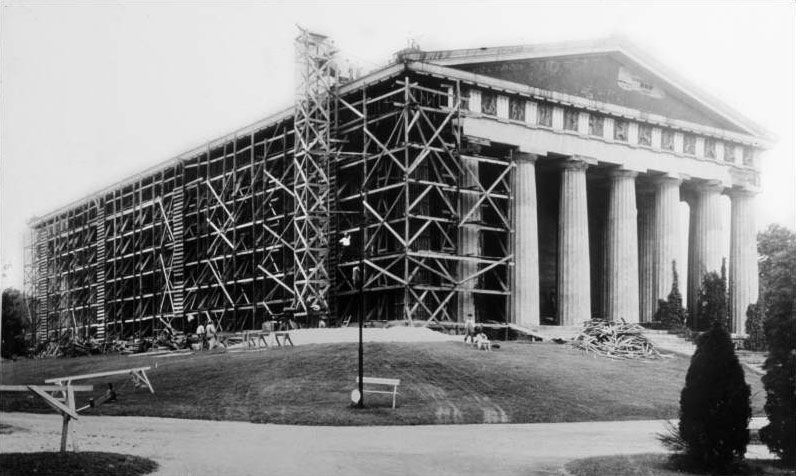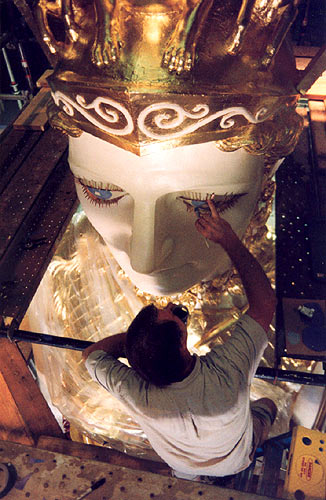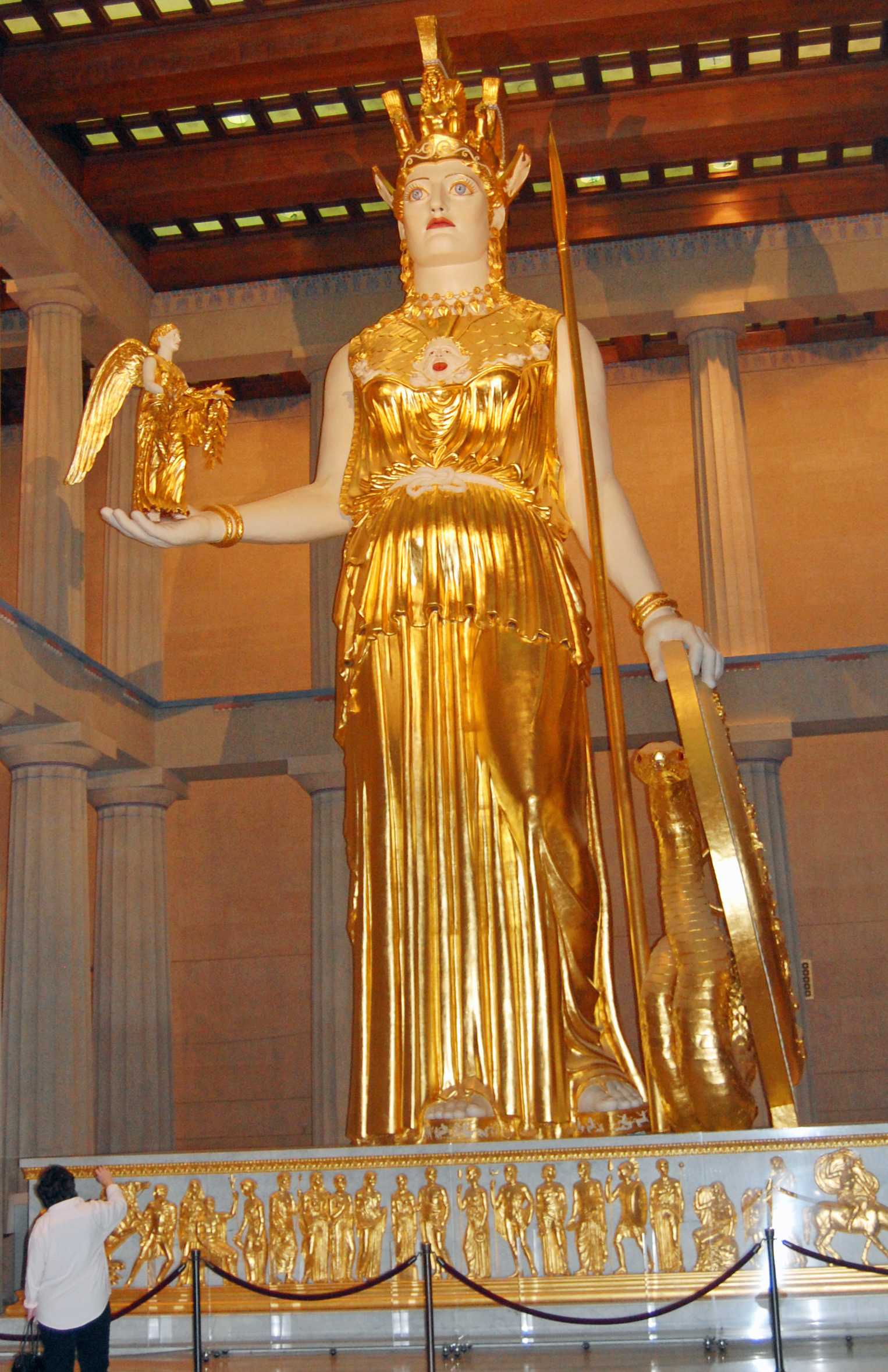Unit 1: Why Study Greek Mythology?
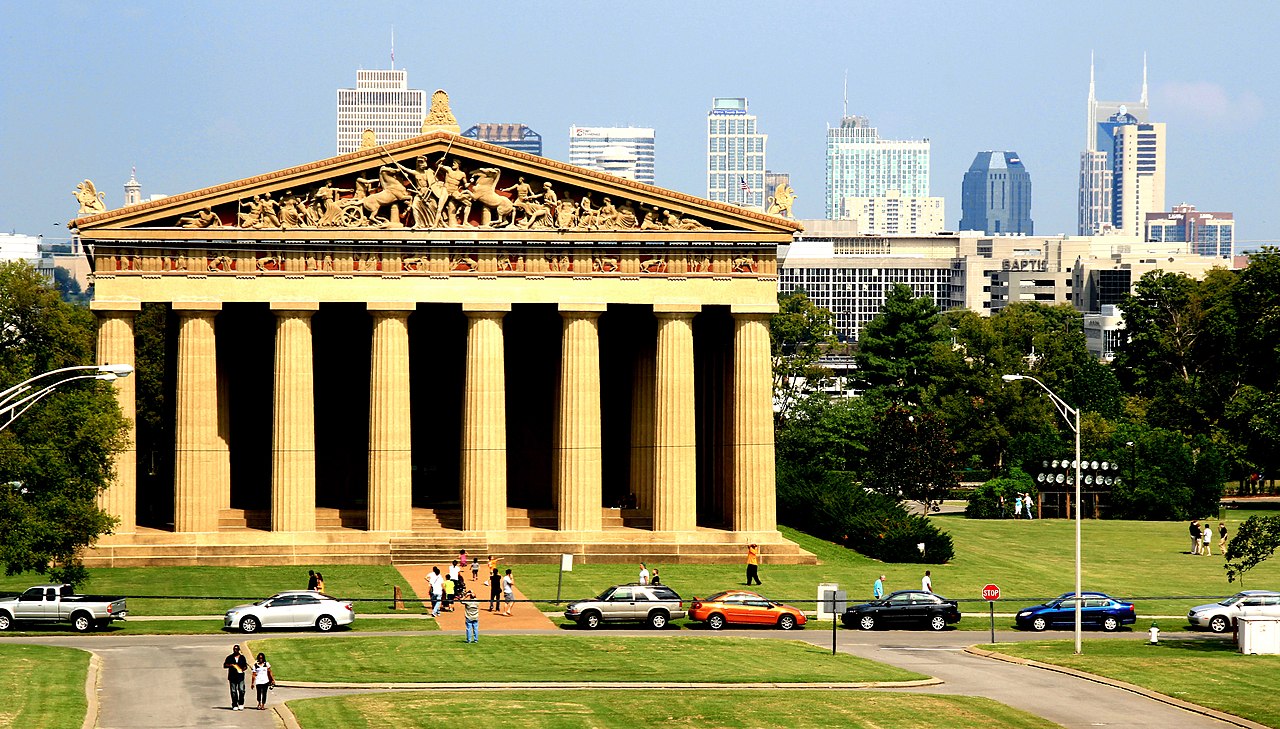
Vocabulary in Context
Guess the vocabulary in bold using the context.
- World fairs and expositions are created to showcase a country’s achievements. For six months, world’s fair organizers create grand architectural buildings to house exhibitions and events related to the country’s economic, cultural, and artistic successes.
- But just as Chicago wanted to outdo Paris, Nashville decided to up the ante in 1897 due to the success of the World’s Columbian Exposition.
- The Chicago Fair set a benchmark for future World’s Fairs and expositions in the United States.
- The planners felt it would be appropriate that the “Athens of the South” also build a replica as close to the original as possible.
- Birmingham was one of the most prolific producers of iron and steel, which helped increase the prosperity of the city.
- An Italian sculptor, Giuseppe Moretti, who also made sculptures in Tennessee, was commissioned to design the Vulcan statue.
- Vulcan was dismantled when the world’s fair ended and shipped back to Birmingham.
- The ancient stories about Hephaestus, or Vulcan, depict the god as powerful, but lame and disfigured.
- The iron cast statue had been filled with concrete when he was placed on the pedestal, and he began to deteriorate. In 1999, Birmingham’s “iron man” had a 14-million-dollar overhaul to repair the damage done and re-cast weakened parts of the statue.
Architecture of US World’s Fairs and Expositions
by Charity Davenport, with material from the Wikipedia article “Parthenon” $\ccbysa$
World fairs and expositions are created to showcase a country’s achievements. For six months, world’s fair organizers create grand architectural buildings to house exhibitions and events related to the country’s economic, cultural, and artistic successes. The first one, the French Industrial Exposition of 1844, flaunted new technologies created during Europe’s industrial revolution. Many world fairs and expos, short for “exposition”, have borrowed ideas and architectural styles from Classical Greece to acknowledge how the past shapes the future.

Many of the early World’s Fairs created pieces of art and architecture that remain famous to this day. The Eiffel Tower was built for the Paris International Exposition of 1889, by Alexandre-Gustave Eiffel, the same man that a few years prior had worked on the design of the Statue of Liberty. Chicago wanted to outdo Paris and commissioned George Washington Gale Ferris Jr. to create what is now known as the Ferris wheel for the World’s Columbian Exposition, held in Chicago in 1893.
The Parthenon
Nashville decided to up the ante in 1897 due to the success of the World’s Columbian Exposition. The Chicago Fair set a benchmark for future World’s Fairs and expositions in the United States, and although Nashville was not hosting a World’s Fair that year, it did host the Tennessee Centennial Exposition to commemorate its 100 year anniversary as a state. At the time, Nashville had earned the nickname “Athens of the South,” referring to the many higher education institutions there as well as the city being the first in the South to create a public school system. Ancient Athens had been the center of education and culture and the home of the Parthenon, a temple built in Athena’s honor in 438 BCE. Thus, the planners felt it would be appropriate that the “Athens of the South” also build a replica as close to the original as possible, even using casts of sculptures found in the original Parthenon. As is usual for many World’s Fair buildings, the pavilions for the exhibitions were not built to be permanent, but the Parthenon was so beloved and popular that they decided to keep it, so it was rebuilt in concrete in 1920, taking eleven years to complete.
The original Parthenon is considered one of the most important surviving building of Classical Greece and as an enduring symbol of Ancient Greece, Athenian democracy and Western civilization, and one of the world’s greatest cultural monuments. To the Athenians who built it, the Parthenon and other monuments of the Acropolis in Athens were seen fundamentally as a celebration of Hellenic victory over the Persian invaders and as a thanksgiving to the gods for that victory. The building served as not only a temple, but a treasury. Towards the end of 500 CE it was a church, and after the Turkish Ottoman took over Greece in the early 1460s, it became a mosque. In 1687 during a war, the Parthenon was used to house ammunition and exploded, causing much of the damage and ruin that is visible to the structure and its sculptures today.
The east and west pediments, the triangular top of the Parthenon that houses life-sized statues, depict interesting stories concerning Athena. The east pediment illustrated the birth of Athena while the west pediment explains how the city became known as Athens. The city of Athens was named after Athena because she was the Athenians’ protector and benefactor, but she had earned that right by winning a competition with Poseidon for patronage over the city. Differing versions say that either Zeus (and possibly other gods) judged the contest or that it was a committee of Athenian kings. Either way, each divinity was asked to provide a gift for the city and the judges would decide who had given the better gift. Poseidon struck a rock with his trident and out came a spring of saltwater, but Athena grew an olive tree. The judges decided that the olive was more useful than the spring and awarded Athena the city.[1]
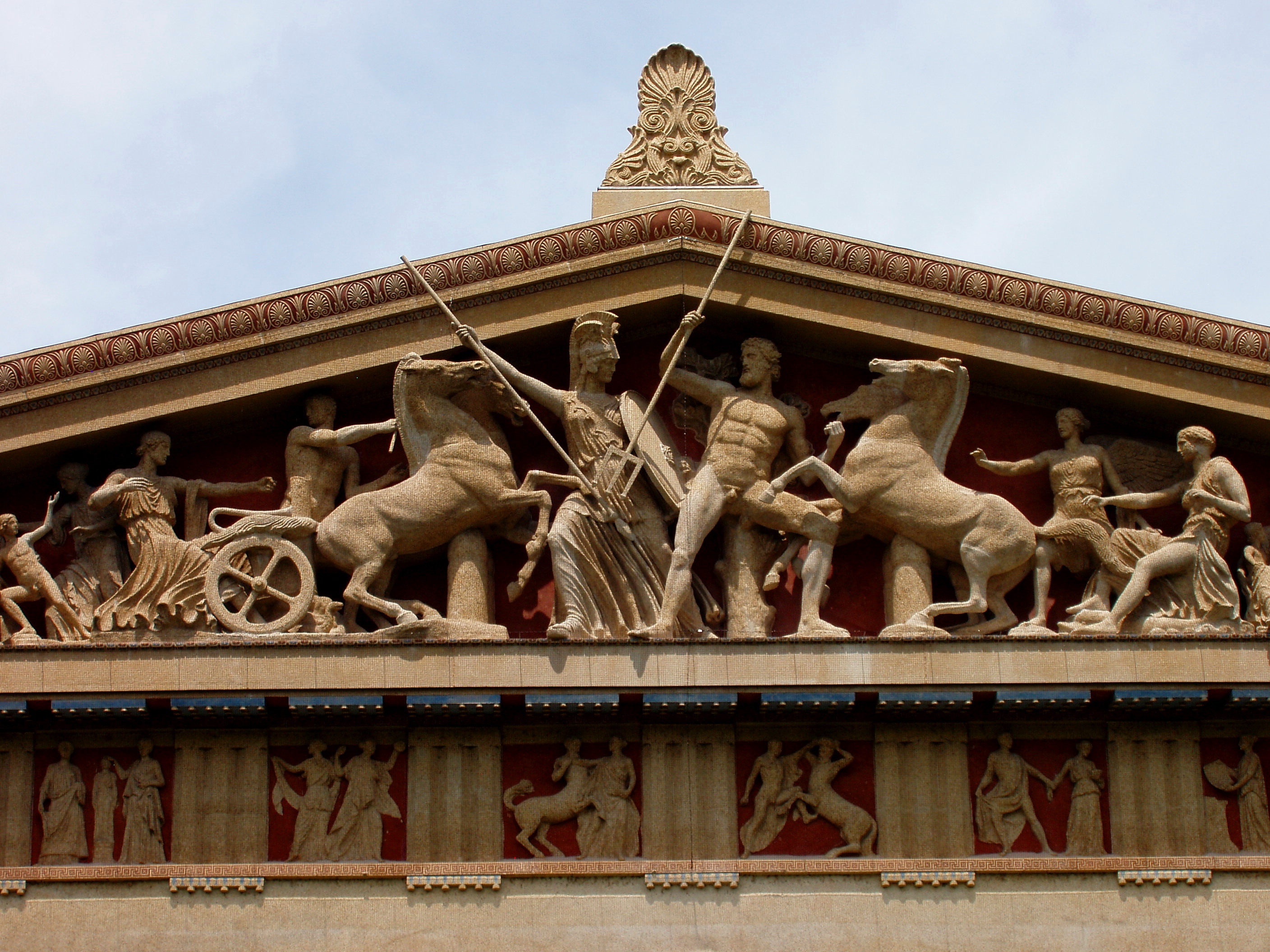
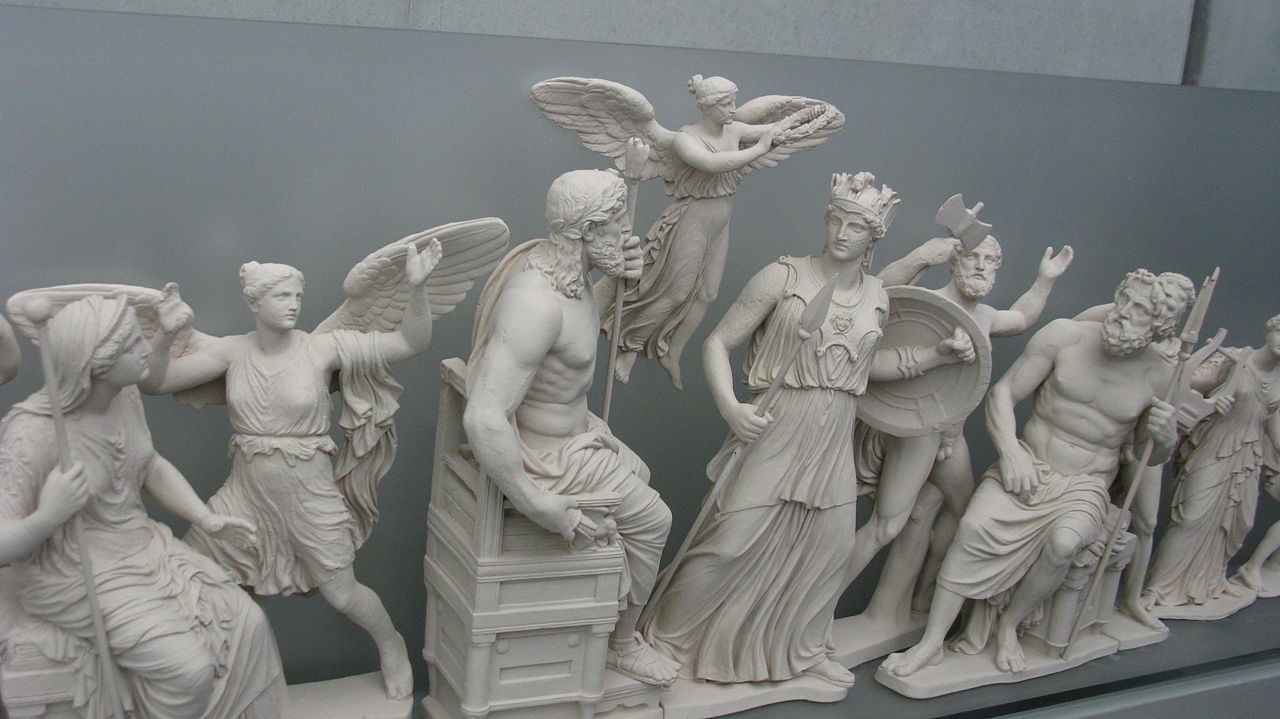
Although it has been protected for historical preservation and sometimes renovated, the original Parthenon in Athens, Greece, partially in ruins, is missing something very important–the statue of Athena, called Athena Parthenos, which once stood tall in the middle of the temple. The Nashville Parthenon also was missing a statue of Athena for almost 100 years. Now stands a statue of Athena, the largest indoor statue in the Western world, at almost 42 feet tall, with a “tiny” Nike, the goddess of victory, standing in her hand at 6 feet tall. Athena was completed in 1990 but she wasn’t painted and gilded to match what she would have looked like originally in Athens until 2002. Currently every summer, well-known classical Greek plays are performed in front of the Parthenon, and Mary Zimmerman’s 1996 play Metamorphoses, which retells stories from Greek mythology, has been performed inside the Nashville Parthenon in front of the goddess herself. The Parthenon in Nashville was even the setting for a scene of a battle with Hydra in the movie Percy Jackson and the Olympians: The Lightning Thief in 2010.
Vulcan Statue
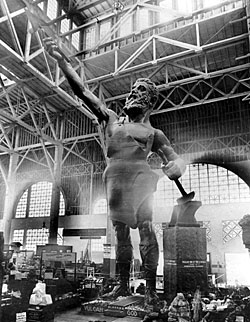
To contribute to exhibits created by 43 states for the 1904 St. Louis World’s Fair, Birmingham, Alabama decided to represent its city with the image of Vulcan, the Roman version of Hephaestus, the god of metal and blacksmithing. At the time, Birmingham was one of the nation’s most prolific producers of iron and steel, contributing to the prosperity of the city. An Italian sculptor, Giuseppe Moretti, who also made sculptures in Tennessee, was commissioned to design the Vulcan statue. A clay master mold was created in New Jersey, divided into parts, and then sent to Birmingham where casting molds were made. Finally, locally produced iron was used on the cast mold to create each piece of the statue. The pieces were sent to St. Louis for the World’s Fair where everyone could learn about the “Iron City” of Birmingham, Alabama. Vulcan was dismantled when the World’s Fair ended and shipped back to Birmingham, where it now stands in Vulcan Park.

The ancient stories about Hephaestus, or Vulcan, depict the god as powerful, but lame and disfigured. The poor Vulcan statue suffered much of the same fate. On his way back home by train, some of his pieces were abandoned beside the railroad tracks. Eventually the pieces were collected and assembled back in Birmingham, but his arms were not put on correctly and his spear had been lost. Advertisers in the city used his empty hand to hold whatever product they wanted to sell, creating advertisements of Vulcan holding an ice cream cone or a Coca-Cola bottle. He was taken apart once again to inspect his arms in the late 1920s and again reassembled in the 1930s. Later, in 1939, a new park, named Vulcan Park, was built on top of a mountain–not Mount Olympus, but Birmingham’s Red Mountain, the highest point in Birmingham, on the edge of the Appalachians. It was the perfect place for an imperfect god to stand, overlooking the downtown area of the city. Vulcan was placed on a 126-foot tall pedestal made of locally produced sandstone.
Unfortunately, once again, poor Vulcan became lame. The iron cast statue had been filled with concrete when he was placed on the pedestal, and he began to deteriorate. In 1999, Birmingham’s “iron man” had a 14-million-dollar overhaul to repair the damage done and re-cast weakened parts of the statue. Finally, he returned to his throne in 2003 with restorations faithful to Moretti’s original design. In 2007 a museum was added to Vulcan Park.
Comprehension and Critical Thinking Questions
Using your own words, answer the questions below according to the reading.
- What two other famous creations inspired designers for the Tennessee Centennial Exposition to make a replica of the Parthenon?
- Why did Nashville build the replica of the Parthenon?
- What are three examples of other functions other than a temple dedicated to Athena that the original Parthenon in Athens had?
- What is missing from inside the original Parthenon that is included in the Nashville replica?
- When was Athena painted, and what color is she?
- Why did the city of Birmingham, Alabama decide to construct a statue of Vulcan?
- What happened to the Vulcan statue after the World’s Fair ended?
- Describe some of the mishaps the poor statue went through over the years.
- Where does the Vulcan statue stand now?
- After reading the article, which piece of architecture do you think is the most interesting? Explain why.
- Discuss with your partner and find pictures of any building or architecture that is about a famous myth or story from your country. Explain the story to your partner.
CEFR Level: CEF Level C1
Did you know?
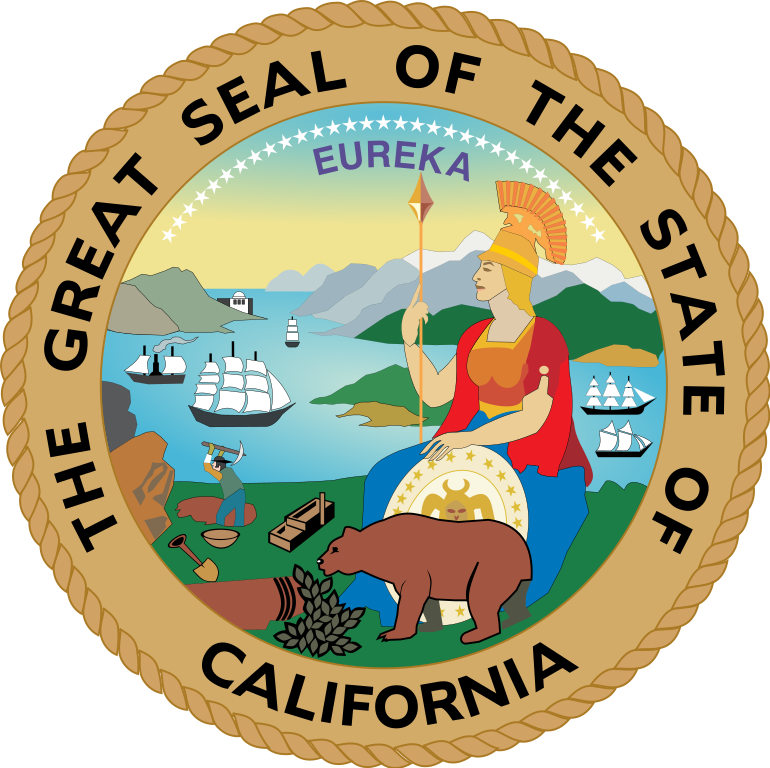
Here is the state seal of California, bearing the image of Athena. At the top it says “eureka,” which is Greek for “I found it!” It became popular after it was known that a famous ancient mathematician, Archimedes, used it when he made the great discovery of determining the purity of gold while taking a bath. Some people use it when they suddenly have a good idea, or they may say “aha!” Now it’s becoming popular to use it to talk about a “eureka moment” someone has. As for the seal, it probably says “eureka” after the discovery of gold made California a popular destination in the late 1800s. “Eureka!” is also California’s official motto. What was your most recent “eureka” moment?
- Text in this paragraph is from Mythology Unbound: An Online Textbook for Classical Mythology by Jessica Mellenthin and Susan O. Shapiro ↵

